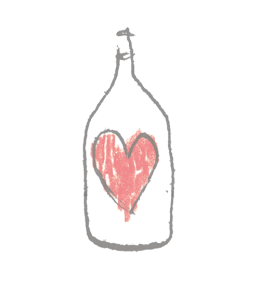The first true vintage of the Cru Barréjats on a dream vintage
the 90 vintage by Mireille Daret:
Cultivating our vines in 1990 in Sauternes was very easy, the climatic conditions being particularly mild: high average temperatures between those of 1988 and 1989, and more abundant rainfall without however compensating for the water deficit that had been going on for several years. These climatic conditions allowed us to have very healthy vines throughout 1990 and therefore to treat very little, with products as natural as sulphur and copper sulphate. The bud break of the vines is early around 20 March, the flowering takes place quite satisfactorily around mid-May and veraison in mid-August.
In mid-September, the dryness of the afternoons and the morning fog allowed a massive attack of Botrytis Cinerea, on very ripe grapes already very rich in sugars. At the end of September, the musts regularly flow at more than 20° in the press, reaching 28° for some “tries”! We are obliged to selectively pick a few non-botrytised grapes in order to enhance the acidity of our wines!
We have optimized this already certain quality, by very careful “sorting”, in order to collect only the nectar. We produced a total of 1200 bottles of Cru Barréjats for a cultivated area of 0.76 hectares, i.e. a yield of 12 hectolitres per hectare (compared to 25 hectolitres usually authorised in the Sauternes appellation).
Pressing in an old vertical hydraulic press (made of wood and stainless steel) makes it possible to express concentrated musts in the best possible way. After settling, fermentation is carried out in new stave oak barrels (Mercier cooper, fine-grained staves with very tight grains, medium toast) and the ageing continues after racking for 18 months. Filtration precedes bottling.
The very candied musts, complex with a lot of fullness, were only a foretaste of the quality of this vintage of great ageing, which will certainly be one of the greatest of this century in Sauternes. The characteristic richness of this vintage and its low acidity slowly cause a white deposit in the form of a shiny powder to appear in the bottles over time, regardless of the storage temperature. It is neutral calcium tartrate, a precipitation that has the character of a stabilization, favorable from the point of view of taste, and commonplace in great and old vintages in Sauternes.
CRU BARREJATS 1990

| Région | Bordeaux |
|---|---|
| Designation | Sauternes |
| Color | sweet |
| Vintage | 1990 |
| Label | AUCUN |
| Capacity | 75cl |
CRU BARREJATS
The first true vintage of the Cru Barréjats on a dream vintage
the 90 vintage by Mireille Daret:
Cultivating our vines in 1990 in Sauternes was very easy, the climatic conditions being particularly mild: high average temperatures between those of 1988 and 1989, and more abundant rainfall without however compensating for the water deficit that had been going on for several years. These climatic conditions allowed us to have very healthy vines throughout 1990 and therefore to treat very little, with products as natural as sulphur and copper sulphate. The bud break of the vines is early around 20 March, the flowering takes place quite satisfactorily around mid-May and veraison in mid-August.
In mid-September, the dryness of the afternoons and the morning fog allowed a massive attack of Botrytis Cinerea, on very ripe grapes already very rich in sugars. At the end of September, the musts regularly flow at more than 20° in the press, reaching 28° for some "tries"! We are obliged to selectively pick a few non-botrytised grapes in order to enhance the acidity of our wines!
We have optimized this already certain quality, by very careful "sorting", in order to collect only the nectar. We produced a total of 1200 bottles of Cru Barréjats for a cultivated area of 0.76 hectares, i.e. a yield of 12 hectolitres per hectare (compared to 25 hectolitres usually authorised in the Sauternes appellation).
Pressing in an old vertical hydraulic press (made of wood and stainless steel) makes it possible to express concentrated musts in the best possible way. After settling, fermentation is carried out in new stave oak barrels (Mercier cooper, fine-grained staves with very tight grains, medium toast) and the ageing continues after racking for 18 months. Filtration precedes bottling.
The very candied musts, complex with a lot of fullness, were only a foretaste of the quality of this vintage of great ageing, which will certainly be one of the greatest of this century in Sauternes. The characteristic richness of this vintage and its low acidity slowly cause a white deposit in the form of a shiny powder to appear in the bottles over time, regardless of the storage temperature. It is neutral calcium tartrate, a precipitation that has the character of a stabilization, favorable from the point of view of taste, and commonplace in great and old vintages in Sauternes.
Other products in the domain CRU BARREJATS
-
More
info
L’INSOUMIS 1998 50cl
CRU BARREJATSSauternes45,00 € + -
More
info
L’ANDALOUSE 1997 75cl
CRU BARREJATSSauternes58,00 € + -
More
info
CRU BARREJATS-DARET 2011 75cl
CRU BARREJATSSauternes45,00 € + -
More
info
CRU BARREJATS-DARET 2010 75cl
CRU BARREJATSSauternes45,00 € + -
More
info
CRU BARREJATS EN MAGNUM 2003 150cl
CRU BARREJATSSauternes120,00 € + -
More
info
CRU BARREJATS EN MAGNUM 1999 150cl
CRU BARREJATSSauternes105,00 € + -
More
info
CRU BARREJATS 1998 75cl
CRU BARREJATSSauternes50,00 € + -
More
info
CRU BARREJATS 2002 75cl
CRU BARREJATSSauternes50,00 € +







